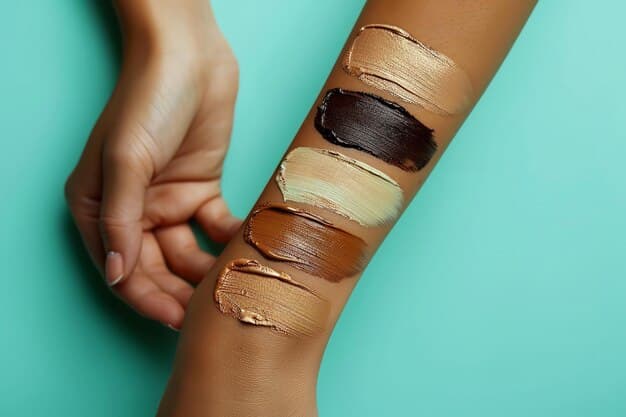The Ultimate Guide: Choosing the Right Foundation for Your Skin (2025)

Choosing the right foundation involves understanding your skin type, desired coverage, and finish, enabling you to select a product that enhances your natural beauty and promotes a flawless complexion.
Finding the perfect foundation can feel like searching for the holy grail in the world of makeup. This The Ultimate Guide to Choosing the Right Foundation for Your Skin Type: Updated for 2025 will simplify the process, ensuring you achieve a flawless, natural-looking complexion that lasts all day.
Understanding Your Skin Type
Before diving into the myriad of foundation options, it’s crucial to identify your skin type. Understanding whether your skin is oily, dry, combination, or sensitive will greatly influence the type of foundation that works best for you.
Identifying Oily Skin
Oily skin is characterized by excess sebum production, leading to a shiny appearance and enlarged pores. People with oily skin often experience frequent breakouts and may struggle with makeup that slides off easily.
Identifying Dry Skin
Dry skin lacks moisture, often feeling tight and flaky. Fine lines may be more noticeable, and makeup can sometimes appear patchy or accentuate dry areas.

Identifying Combination Skin
Combination skin features both oily and dry areas, typically with an oily T-zone (forehead, nose, and chin) and dry cheeks. Balancing hydration and oil control is key for this skin type.
Identifying Sensitive Skin
Sensitive skin is prone to irritation, redness, and allergic reactions. It requires gentle, hypoallergenic products free from harsh chemicals and fragrances.
- Oily Skin: Look for oil-free, non-comedogenic, and matte foundations.
- Dry Skin: Opt for hydrating, moisturizing, and dewy foundations.
- Combination Skin: Choose a balanced formula that controls oil in the T-zone while hydrating dry areas.
- Sensitive Skin: Select hypoallergenic, fragrance-free, and non-irritating foundations.
Knowing your skin type is the first step in finding the foundation that will enhance your natural beauty. By understanding your skin’s unique needs, you can make an informed decision and achieve a flawless complexion.
Choosing the Right Foundation Formula
Foundations come in various formulas, each offering different benefits and catering to specific skin types and preferences. From liquid to powder to cream, the options can be overwhelming.
Liquid Foundations
Liquid foundations are versatile and come in various finishes, from matte to dewy, offering sheer to full coverage. They are suitable for most skin types, depending on the specific formulation.
Powder Foundations
Powder foundations are ideal for oily skin, providing a matte finish and helping to control shine. They are easy to apply and offer buildable coverage. However, they may not be suitable for dry skin, as they can accentuate dry patches.
Cream Foundations
Cream foundations are moisturizing and offer medium to full coverage, making them suitable for dry and mature skin. They provide a smooth, radiant finish and can help to minimize the appearance of fine lines and wrinkles.
Stick Foundations
Stick foundations are convenient and offer buildable coverage, making them great for on-the-go application. They are suitable for most skin types and can be used as a concealer or for touch-ups.

- Coverage Levels: Sheer, medium, and full.
- Finishes: Matte, dewy, natural, and radiant.
- Skin Type Compatibility: Varies depending on the formula and ingredients.
Selecting the right foundation formula depends on your skin type, desired coverage, and preferred finish. Understanding the characteristics of each formula will help you make the best choice for your skin.
Understanding Foundation Coverage and Finish
The coverage and finish of a foundation play a significant role in achieving your desired look. Whether you prefer a natural, barely-there finish or a full-glam look, understanding these aspects is essential.
Coverage Levels: Sheer, Medium, and Full
Sheer coverage foundations provide a natural, barely-there look, evening out the skin tone without completely masking imperfections. They are great for those with relatively clear skin who want a natural finish.
Finish: Matte, Dewy, and Natural
Matte finishes are shine-free and provide a velvety smooth appearance, making them ideal for oily skin. Dewy finishes offer a radiant, luminous look, perfect for dry skin. Natural finishes strike a balance between matte and dewy, providing a healthy, skin-like appearance.
Choosing the right coverage and finish depends on your skin type, desired look, and personal preferences. Experiment with different options to find what works best for you.
Choosing the Right Shade and Undertone
Selecting the correct foundation shade and undertone is crucial for achieving a seamless, natural-looking complexion. A foundation that is too light or too dark will be easily noticeable, and an incorrect undertone can make your skin look ashy or orange.
Understanding Undertones: Warm, Cool, and Neutral
Undertones refer to the subtle hues beneath the surface of your skin. Warm undertones have yellow or golden hues. Cool undertones have pink or blue hues. Neutral undertones have a balance of both.
- Warm Undertones: Look for foundations with yellow or golden hues.
- Cool Undertones: Opt for foundations with pink or blue hues.
- Neutral Undertones: Choose foundations with a balance of warm and cool hues.
Matching Your Foundation Shade
To find your perfect shade, test the foundation on your jawline in natural light. The shade that disappears into your skin is the right match. If you’re between shades, opt for the lighter one.
Finding the right shade and undertone is essential for a natural-looking finish. Take the time to understand your undertone and test shades in natural light to find your perfect match.
Application Techniques for Flawless Foundation
The way you apply your foundation can greatly impact the final result. Using the right tools and techniques can help you achieve a flawless, long-lasting finish.
Tools of the Trade: Brushes, Sponges, and Fingers
Different tools offer varying levels of coverage and finish. Brushes provide more coverage, while sponges create a more natural, airbrushed look. Using fingers can warm up the product and blend it seamlessly into the skin.
Step-by-Step Application Guide
Start by prepping your skin with a moisturizer and primer. Apply a small amount of foundation to the center of your face and blend outwards using your preferred tool. Build coverage as needed, focusing on areas that require more attention.
Setting Your Foundation for Longevity
To ensure your foundation lasts all day, set it with a translucent powder. Focus on areas that tend to get oily, such as the T-zone. Use a setting spray for added longevity.
Mastering the right application techniques can elevate your foundation game. Experiment with different tools and methods to find what works best for you.
Top Foundation Recommendations for 2025
As we look ahead to 2025, several foundations are emerging as top contenders for various skin types and preferences. These foundations combine innovative formulas, long-lasting wear, and skin-loving ingredients.
Best Foundations for Oily Skin
For oily skin, look for foundations that offer a matte finish and oil control. Some top picks include:
- [Brand Name] Matte Foundation: Known for its long-lasting wear and oil-absorbing properties.
- [Brand Name] Oil-Free Foundation: Provides a natural matte finish without clogging pores.
Best Foundations for Dry Skin
For dry skin, opt for hydrating foundations that provide a dewy finish. Some excellent choices include:
- [Brand Name] Hydrating Foundation: Infused with hyaluronic acid for lasting hydration.
- [Brand Name] Dewy Finish Foundation: Offers a radiant glow and minimizes the appearance of dry patches.
Best Foundations for Combination Skin
Balancing oil control and hydration is key for combination skin. Consider these options:
- [Brand Name] Balancing Foundation: Controls oil in the T-zone while hydrating dry areas.
- [Brand Name] Natural Finish Foundation: Provides a healthy, skin-like appearance with balanced coverage.
Exploring the top foundation recommendations for 2025 can help you discover new favorites and stay ahead of the curve in the world of beauty.
| Key Aspect | Brief Description |
|---|---|
| ✨ Skin Type Identification | Determine if you have oily, dry, combination, or sensitive skin for targeted product selection. |
| 🎨 Formula Choice | Select liquid, powder, cream, or stick foundations based on your skin’s needs and desired finish. |
| 🌈 Coverage & Finish | Decide on sheer, medium, or full coverage, and choose between matte, dewy, or natural finishes. |
| 🔍 Undertone Matching | Identify warm, cool, or neutral undertones to select the correct foundation shade for a seamless look. |
Frequently Asked Questions
▼
Observe your skin throughout the day. Oily skin will appear shiny, dry skin will feel tight, combination skin will have oily and dry patches, and sensitive skin will react easily to products.
▼
Apply a small amount of foundation to your jawline in natural light. The shade that blends seamlessly with your skin is the best match.
▼
Yes, mixing foundation formulas can help you customize the coverage and finish. Experiment with different combinations to find what works best for you.
▼
Replace your foundation every 6-12 months to prevent bacterial contamination and ensure optimal performance of the product.
▼
A foundation primer creates a smooth base, helps your foundation last longer, and can target specific skin concerns like oiliness or dryness.
Conclusion
Choosing the right foundation for your skin type is a journey that requires understanding your skin’s unique needs, exploring different formulas and finishes, and mastering the application techniques. By following this ultimate guide, you’ll be well-equipped to find the perfect foundation that enhances your natural beauty and promotes a flawless complexion in 2025.





